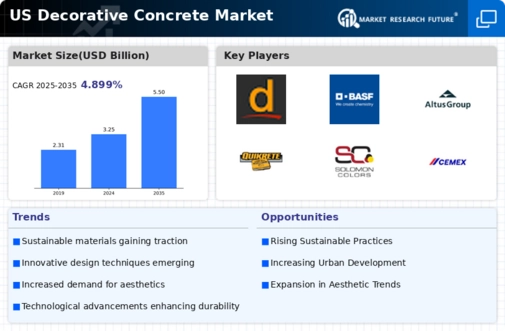Expansion of Commercial Applications
The expansion of commercial applications significantly impacts the decorative concrete market, as businesses increasingly recognize the benefits of using decorative concrete in their facilities. Retail spaces, restaurants, and office buildings are adopting decorative concrete for its aesthetic versatility and cost-effectiveness. Market data suggests that the commercial segment is projected to account for over 40% of the total decorative concrete market by 2030. This growth is attributed to the rising demand for unique and engaging environments that attract customers and enhance brand identity. As more businesses invest in decorative concrete solutions, the market is likely to experience substantial growth, driven by the need for innovative and visually appealing commercial spaces.
Rising Demand for Aesthetic Solutions
The decorative concrete market experiences a notable surge in demand for aesthetic solutions, driven by the increasing consumer preference for visually appealing surfaces in residential and commercial spaces. Homeowners and businesses alike are seeking unique designs, colors, and textures that enhance the overall ambiance of their properties. This trend is reflected in the market data, which indicates that the decorative concrete segment is projected to grow at a CAGR of approximately 6.5% from 2025 to 2030. As architects and designers increasingly incorporate decorative concrete into their projects, the market is likely to witness a significant expansion, catering to the evolving tastes of consumers who prioritize aesthetics alongside functionality.
Infrastructure Development Initiatives
Infrastructure development initiatives across the United States play a crucial role in propelling the decorative concrete market. Government investments in public works, including roads, bridges, and public spaces, have led to an increased demand for durable and visually appealing concrete solutions. The market is expected to benefit from the projected $2 trillion infrastructure plan, which emphasizes the use of decorative concrete for its longevity and low maintenance requirements. This trend not only enhances the aesthetic appeal of urban environments but also aligns with sustainability goals, as decorative concrete can contribute to energy efficiency and reduced environmental impact. Consequently, the decorative concrete market is poised for growth as infrastructure projects continue to unfold.
Growing Interest in Outdoor Living Spaces
The growing interest in outdoor living spaces significantly influences the decorative concrete market. As homeowners increasingly invest in their outdoor areas, the demand for decorative concrete solutions such as patios, walkways, and pool decks has risen. This trend is supported by market data indicating that the outdoor living market is expected to reach $200 billion by 2026, with decorative concrete playing a pivotal role in enhancing these spaces. The versatility of decorative concrete allows for various designs and finishes, appealing to consumers looking to create functional yet aesthetically pleasing outdoor environments. As this trend continues, the decorative concrete market is likely to expand, catering to the evolving preferences of homeowners.
Increased Focus on Durability and Maintenance
The decorative concrete market is witnessing an increased focus on durability and maintenance, as consumers prioritize long-lasting solutions for their properties. With the rising costs of repairs and replacements, homeowners and businesses are seeking materials that offer both aesthetic appeal and resilience. Decorative concrete, known for its strength and low maintenance requirements, aligns well with these consumer preferences. Market analysis suggests that the demand for durable decorative concrete solutions is expected to grow, particularly in regions with harsh weather conditions. This trend indicates a shift towards investing in high-quality materials that provide value over time, thereby driving the decorative concrete market forward.






















Leave a Comment